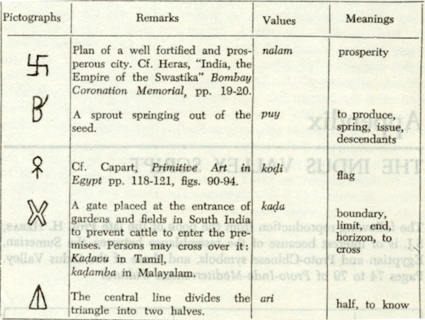 There are 241 pictographs in this script. These are signs that do not represent any object in a pictographic way. Of this kind are many signs to which abstract ideas correspond, for such abstract ideas cannot be shown pictographically. Other signs that are now placed within this range were probably pictographs in more ancient times. These signs, having developed and lost their pictographic appearance, are now being classified among the phonetic signs. These signs themselves could not help us much to know their meaning. Hence they were compared with signs of other ancient scripts in the hope that similar signs of those scripts might have the same meaning. The Iberian, Etruscan, linear Minoan, Cypriote and Phoenician could not give us any help, for all these writings are alphabetic. Moreover, some of these scripts have not yet been deciphered. Amongst the ancient scripts of old Mediterranean nations, Sumerian, Egyptian and Hittite scripts supplied us with many meanings. Another non-Mediterranean script which was of great help, was the Proto-Chinese script which has been recently discovered. The neighbourhood of India and China sufficiently explains the similarity between signs of the first scripts of these two nations.1 Moreover two terracotta heads with evident Chinese features, which were discovered at Mohenjo-Daro, prove beyond any possibility of doubt ------------------------------------------------------------------------------------------------------------------ 1Cf. Heras, "The Velālas of Mohenjo-Daro", p. 47. |